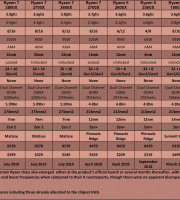


The Rt. Hon Voice of Slight Logic vs. An Nvidia Apologist.
Nvidia Apologist: Please understand. The Titan X is targeted at the most demanding and broad minded of extremists. Gamers who lust after omnipotence in an ultra HD utopia and covet computation beyond the realm of deep thought.
Voice of Slight Logic: A crafty double allusion there, deep thought as in “the ultimate question”, and “deep learning” as in breeding AI correct? Very clever. But can the Titan X really talk all four legs off an Arcturan Mega-donkey?
Nvidia Apologist: It can…and persuade it to race around the rings of Saturn afterwards.
Voice of Slight Logic: Very impressive. But what of the 295X and its compute capacity, its half brother does more than trade teraflops with a Titan Black 5.6 to 5.1, what could 11.2 do to a Titan X?
Nvidia Apologist: Disposable statistics my friend, a GPU’s CV can be a riveting read, we try to spice ours up too, but it the real world, experience is what counts, and counts, and counts, and counts.
Voice of Slight Logic: Indeed, but this doesn’t only concern specifications, look at the evidence, this troubling set of results for instance. Luxmark 2, a gamut of Sandra benchies, not to mention the Basemark CL suite. A total of 14 tests and the Titan Black soundly thrashed in 12. By a margin of 100% or more in ten, and 200% or more in six. I’d call that pretty decisive. Even your imperious Titan-Z gets mashed in 11 out of 3 cases and for twice as much money.
Nvidia Apologist: I note those are all single precision tests.
Voice of Slight Logic: Go ahead and glance at the next page, the figures equally grim. The Titan-Z loses in 4 out of 6 and Titan Black is hammered 5-1. Besides, we needn’t worry about double precision, the Titan-X sports no such talent. You suppressed it, remember?
Nvidia Apologist: Correct, to further improve single precision for CUDA apps and games and trust me, we have. Furthermore, consider over 6 teraflops of mathematical mastery, combined with 12 gigs of RAM, as much as the Titan-Z, but dedicated to one chip. And that review is ancient. Find me some benchmarks that actually pit the Titan-X against your bloated beloved and I’ll be surprised if those margins haven’t altered, dramatically.
Voice of Slight Logic: You seem unusually keen to promote memory in light of recent inaccuracies. Only last month you were claiming that a minuscule proportion of games would draw on last half gig of what was purportedly a 4 gig card
Nvidia Apologist: Let’s not take cheap shots.
Voice of Slight Logic: Why, I prefer them to your expensive ones.
Nvidia Apologist: 4 gigs is plenty for now, 6 is a luxury, but who can predict next year’s demands?
Voice of Slight Logic: You desgned this product to make 4k feasible for a single GPU right?
Nvidia Apologist: We did, and it has.
Voice of Slight Logic: Barely.
Nvidia Apologist: Squarely.
Voice of Slight Logic: I’ll not bicker, but you know the transient nature of technology. Next year?!` By then your target demographic will be gaming at 8K. Big Maxwell himself will be the bottle neck, not his RAM, and you’ll passionately be preaching the virtues of his successor’s cores and rops. Baby, Mummy and Daddy Pascal.
Nvidia Apologist: I’m not in the position to speculate, but there’s no law to that obliges you to passively embrace our latest architecture. Titan X adopters could easily circumnavigate that bottle neck by investing in a second card. A practical and risk free proposition, and enough to carry any sentient Steamer safely though the next resolution revolution.
Voice of Slight Logic: And what will you have lowered its price to? 50% I hope.
Nvidia Apologist: I shan’t hypothesize
Voice of Slight Logic: Well, that would be reasonable for what by then will be middle tier technology.
Nvidia Apologist: My pipelines are sealed.
Voice of Slight Logic: Come on. Will you lower it at all?
Nvidia Apologist: No comment.
Voice of Slight Logic: Forgive my suspicions but I get the feeling you might furtively wind down production as soon as the Pascal arrives, in whatever form that is.
Nvidia Apologist: Why would you think that?
Voice of Slight Logic: Because that’s what happened with the original Titan when the Maxwell made its début. Plus, I don’t remember its price budging more than a farthing unless you happened to stumble on a clearance or were willing to go second hand.
Voice of Slight logic: One last query on memory before it slips my own.
Nvidia Apologist: All ears.
Voice of Slight Logic: Care to explain why it states on your site that this thing needs 24 gigs of RAM to run properly?
Nvidia Apologist: That’s not a requirement.
Voice of Slight Logic: It says recommended.
Nvidia Apologist: It does. But 4 gigs is the minimum, rest assured the card will run with that, and with all cores firing…figuratively. 24 streaming multis, 96 ROPs, 3 megs of l2 cache and 12 gigs of VRAM, un-segmented un-partitioned with every memory channel chucking data stripes to the crossbar at 336gb/s. No trimming for the sake of yields, no, fused-off cache, no absent render units or subjugated controllers. All components fully accessible and maximum bandwidth available the entire time. Is that clear enough?